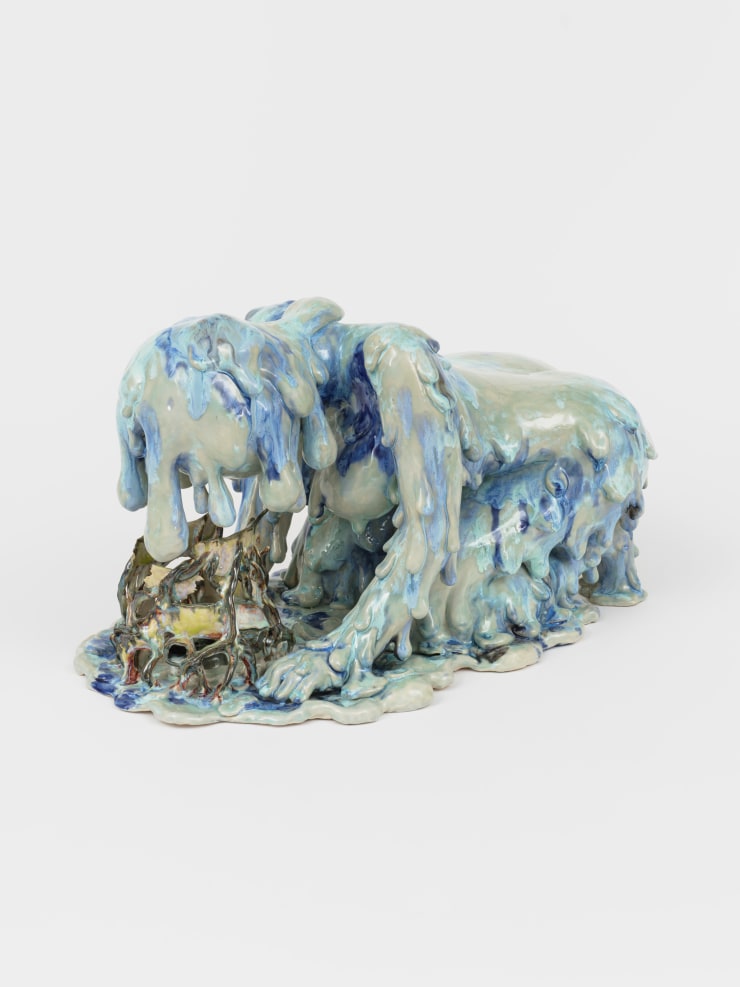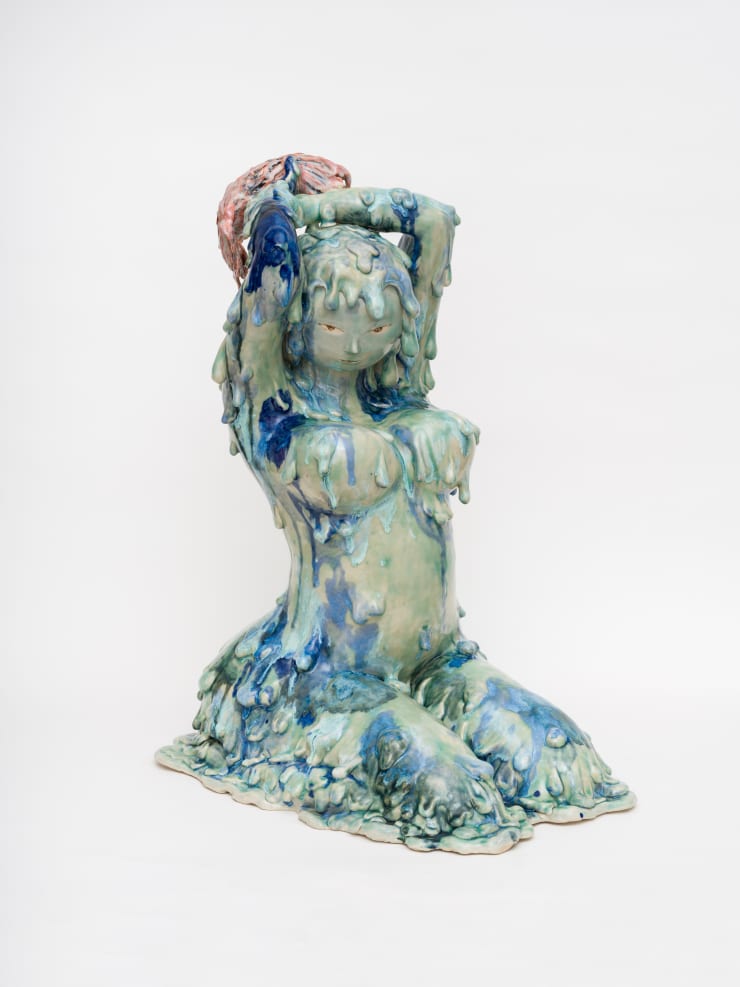Amia Yokoyama "Unfurling Edge"
Sebastian Gladstone is thrilled to announce "Unfurling Edge," a solo exhibiton of ceramic sculptures, holograms, video, and installation by the Los Angeles-based artist Amia Yokoyama. The exhibition will open on Friday, June 23 with a reception from 6-9pm, and run through July 22nd, 2023.
"Like worms, a hologram can be cut into tiny pieces and remain whole. The image doesn’t crack, splinter, puncture, or tear, like a photograph or a painting might; it reconstitutes its own completeness in every fragment. A girl is there in the picture, and there, and there again—an infinite odalisque. She melts, but cannot break. In Amia Yokoyama’s work, no rupture is fatal. This is a digitized and muddy mythology of bodies that split open and grow from their own wounds as if they were made of soil. Her holograms are enclosed in ceramic frames that undulate with the same molten quality of the chlorophyllic figures inside. Pumice, frothy, and obsidian, like a scalpel—different forms of volcanic glass—emerge from the armature, small treasures in a reliquary. Yokoyama offers a new kind of consecration: that which is one thing, but also another, not halved but a simultaneous eruption of both. That which is flat but also sculptural, that which is hard but also soft, that which is familiar but also alien, that which is a girl but also the murky, sodden beginning of the universe.
In Yokoyama’s piece, Promise Theory, an eco-system of image reproduction is built from porcelain and video, light flickering through the capillary structure. Evoking a scientific diagram of a life cycle, moving us through stages of growth and decay, or a breathing tide that spumes from the flushed surface of a monitor, Promise Theory also has the faint glimmer of an altar. Bamboo rhizomes have the same properties as worms, holograms, and imaginary girls made of slime. They are not exactly roots, or seeds, but a third, different thing: regenerative, not reproductive. Yokoyama’s father dug up clumps of rhizomes from the bamboo forest in rural Japan where he grew up, carried them home in his suitcase, and began to grow a small, secret forest underneath his stairs in Chicago. He mailed Yokoyama some of the rhizomes so she could have her own part of the forest, but they died in transport. In her sculpture, Yokoyama uses these relics as architecture, building a veil between the viewer and her animation, a curtain of possibility that frames and obscures the screen. On another arm, a glass rhizome glows, cast from the biological remains of her father’s childhood.
Yokoyama’s scaffolding—particularly the temporary frameworks that she used to support her larger figures in the kiln—has been incorporated into her new work, emphasizing the reciprocity of her structures, the vulnerability of her materials and the raw tactility of aid. At first, they might seem like cages, with slime girls lounging, climbing, peeking through the latticework, but they do not enclose, merely uphold. Like a skeletal honeycomb, or a dried, eidolic snakeskin, they are demarcations of space, neither inside nor outside. Braided porcelain drips from the ledges of a wet-seeming, moss-colored trellis. Yokoyama has built the ropy webbing of relationship that our bodies crawl through and around, seeking other selves. As the slime girls proliferate through her practice, they grow into an arborescent multiplicity; sometimes they seem like the same girl, endlessly doubled, and sometimes they seem hyper-matrilineal, a network of sisters that are also mothers that are also babies. ‘Network,’ a word so dulled by the myopic pressures of our current technology, is returned to its open tracery—the green curl of a fern, the iron ribs of a shrine.
The earliest mirrors were bowls of water, hushed into still reflection. Then, polished obsidian—a black hole, a sudden face. Glass is a state between liquid and solid, an “amorphous solid,” neither here nor there, ocean nor bone. When sand melts, its entire internal structure changes, and after it is cooled back into objecthood, it never becomes truly solid again. Instead, it holds the crystalline inheritance of its earthy beginnings, and the molecular randomness of its brief fluidity, all at once. Yokoyama’s glass sculptures are lambent creatures, retaining the smudged details of digitized selves, the seams of discarded molds. On human bodies, our transformations leave the knotty fortifications of new skin; we, too, can never return to our original form. Yokoyama’s work has a mournful insistence, humming underneath a utopic proposition: ours is a clunky, memory-laden metamorphosis, but a metamorphosis, nonetheless. "
-Audrey Wollen
-
 Amia Yokoyama, Abound, 2022-2023
Amia Yokoyama, Abound, 2022-2023 -
 Amia Yokoyama, Tower (Accumulation), 2022-23
Amia Yokoyama, Tower (Accumulation), 2022-23 -
 Amia Yokoyama, Abyss, 2022-23
Amia Yokoyama, Abyss, 2022-23 -
 Amia Yokoyama, 4th Stage (regeneration), 2022-23
Amia Yokoyama, 4th Stage (regeneration), 2022-23 -
 Amia Yokoyama, On the Brink, 2022-23
Amia Yokoyama, On the Brink, 2022-23 -
 Amia Yokoyama, Head (As the light of day breaks darkness), 2022-23
Amia Yokoyama, Head (As the light of day breaks darkness), 2022-23 -
 Amia Yokoyama, Tail (Feathers or Flame), 2022-23
Amia Yokoyama, Tail (Feathers or Flame), 2022-23 -
 Amia Yokoyama, Bird Blossom Tree, 2023
Amia Yokoyama, Bird Blossom Tree, 2023 -
 Amia Yokoyama, Braid Blade Tree, 2022-23
Amia Yokoyama, Braid Blade Tree, 2022-23 -
 Amia Yokoyama, For Pykos and Psyche, 2022
Amia Yokoyama, For Pykos and Psyche, 2022 -
 Amia Yokoyama, Inflorescence , 2022-23
Amia Yokoyama, Inflorescence , 2022-23 -
 Amia Yokoyama, Kirin, 2022-23
Amia Yokoyama, Kirin, 2022-23 -
 Amia Yokoyama, Swill, 2022-23
Amia Yokoyama, Swill, 2022-23 -
 Amia Yokoyama, Like the Blazing Water, I Too am Burning , 2022-23
Amia Yokoyama, Like the Blazing Water, I Too am Burning , 2022-23 -
 Amia Yokoyama, Mirror 1 / Glint , 2022-23
Amia Yokoyama, Mirror 1 / Glint , 2022-23 -
 Amia Yokoyama, Mirror 2 / Entanglement , 2022-23
Amia Yokoyama, Mirror 2 / Entanglement , 2022-23 -
 Amia Yokoyama, Mirror 3 / In Surround , 2022-23
Amia Yokoyama, Mirror 3 / In Surround , 2022-23
























